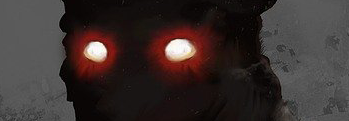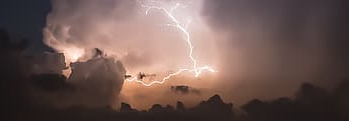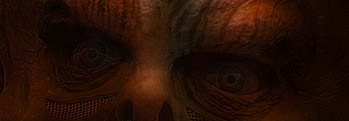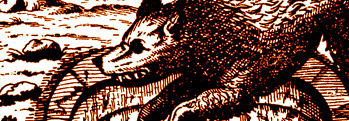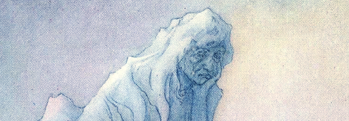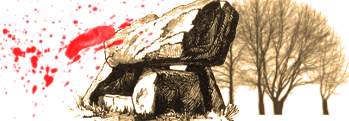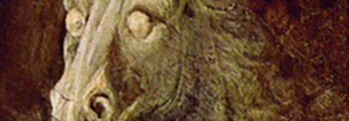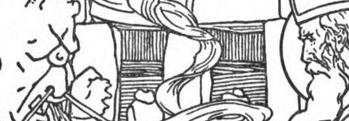An Cailleach
Irish and Celtic myths and legends, Irish folklore and Irish fairy tales from Irish Gods and Monsters
An ancient witch of the earliest days, the Cailleach
An Cailleach or the veiled woman is among the most ancient deities venerated in Ireland, she whose realm lies in the ice and cold of winter. Once it was said that she ruled all the world, when the green things slept for untold aeons beneath her thick icy cloak, until she was given cause for great sorrow and wept floods of tears across the land, her heart melting to a thaw and letting loose the rivers.
 As she wept she dropped many large rocks from her apron which became mountains and hills, and her hammer shaped the valleys below. Some even go so far as to say that from her sprang all the spirits and Sidhe of the old world!
As she wept she dropped many large rocks from her apron which became mountains and hills, and her hammer shaped the valleys below. Some even go so far as to say that from her sprang all the spirits and Sidhe of the old world!
She is known by many names far and wide, an Cailleach Béara for her home in Cork and Kerry, Digde and Milucra, Brónach which means sorrow, Queen of the Little Sun, and it was herself that was said gave Fionn Mac Cumhaill his grey hair. When Fintan the Wise of the hundred lives came to Ireland before the flood he thought himself the first but found Cailleach living there, and knew her to be far more ancient than himself.
He asked of her, “Are you the one, the grandmother who ate the apples in the beginning?” but she gave him no answer.
She grows old in autumn and becomes younger as the winter passes, until in spring she relinquishes her hold and lets the summer flowers blossom. The first farmer to take in his crops at harvest time would make a little poppet of the crop's last sheaf and throw it into his neighbour's field, who would then hurry to take in their own crops and throw the doll into the next field. The last farmer to take in his crops had to feed and house the Old Lady, and fierce were the struggles to avoid having to accommodate that wintry guest!
The last sheaf of all was feared by young women, for if they tied it they believed they'd never be married but live alone like an Cailleach. Thankfully, feeding the last sheaf to a sheep would avert the spinster's fate.
Countless lone standing stones throughout Ireland and Europe are said to be sacred to her, as when she was done bringing the winter she'd cast her staff beneath a holly tree or gorse bush and turn into a stone until the spring.
She lays claim to the creatures of the wild and cold places, the red deer and the wolf, the leaping salmon and the springing goat, warding them and watching over them. She it was who decided which would live and which would perish in the storms of winter, and for this she is also known as the Hag of Storms.
An Cailleach lived (and rumour has it, lives still!) in the Beara jut in the south of Ireland, and a wandering friar came to her house, for he had heard tell of a woman of great age, so old that even she herself had lost count of the years. Her house was small enough and he didn't think much of it, but she made himself and his scribe welcome.
“If it's no harm,” he asked, “may I know your age, as there are those who say you're older than the road I walked to get here, and the fields around it, and the hills in which they lie!”
“No harm to me at all,” she answered, “for I've little to say about it, knowing even less! But I do kill an ox every year and stew up the bones for my soup, then throw a leg bone up into that loft above your head. If you send your young lad up he can make a tally.”
Well the friar's lad went up a the narrow ladder to the loft and began throwing bones down as there was no room to do a count up there in the dimness, and for each one the friar made a mark in a thick book he bore with him. At length the book was full of marks and the friar was weary with totting, so he shouted up to the lad to ask was he almost done.
The lad stuck his head out and said he hadn't even one corner cleared yet, so the friar looked askance at the old woman and bid him come down out of it, for he was up to his knees in bones. He spoke to the lady and learned of some of the wonders she could recall, and they were strange tales indeed that hardly made much sense. But for all that he didn't write them down as his book was already full.
The Beara peninsula is marked on the map below, and rich are the legends the people of that place could tell you.
More Irish Gods and Monsters
It is during the darkest winter nights that we sit inside our houses and listen to the wind hammering at our windows and doors, as if it had a mind and will of its own – as if it wished to do us harm! The old people of Ireland believed that was the literal truth, that there were demons of the air, or demna aeóir thronging about the ... [more]
The dragons of Ireland were not like the dragons of other places, since they did not have wings or often even claws, and only rarely did they breathe fire, if at all! The were called the Ollphéisteanna, which means “great worms” or “mighty reptiles”, the terrible serpents of the world that was. The greatest among t ... [more]
It's well known that the people of Ireland are gifted in poetry, music, writing and the arts, and many have to come to these shores to admire these works. But there is one who moves through the misty glens and dappled glades of Ireland and it is the poets who whisper to her in the darkest hours of the night, hoping for an answer! This fairy ... [more]
In Ireland of old, the Alp-Luachra was one of the most dreaded of all the fairy folk. It also went by the name of Joint-eater, Just-halver, Art-Luachra, Airc-Luachra, and Doichi-Luachair. This creature made its abode in Irish streams and rivers and any place where green life grew from water. Outside of a person it was not much to look at, being ... [more]
Among all the fairy folk who wander the mists and glimmerings of Irish folklore, there are few as feared as the Fear Gorta, whose name means “the Hungry Man”. When hunger stalks the land, it does so as a hound following the footsteps of the Fear Gorta, a solitary, gaunt and masterless spirit of emaciated appearance. Now this fairy is ... [more]
One of the great terrors of ancient – and not so ancient! – Ireland was the Cú Sidhe, or the hound of the Sidhe. This monstrous beast was known in all of the lands once ruled by the Gael, being called the cù-sìth in Scotland and the Cŵn Annwn in Wales. They were also known as the Coinn Iotair, Hounds of Rage, whi ... [more]
A name which echoes through many ancient Irish myths and legends is that of the spirit of the oceans, Manannán mac Lir. Was he a Gaelic god and father of gods, a powerful king of old, first among the Tuatha De Danann, a title for a cult of secretive mystics or a Lord of the Otherworld? Perhaps all of these and more, or none. The earliest ... [more]
Across the northern parts of Ireland and Scotland people sometimes whisper of a terrifying spirit that can sometimes be seen before a big storm hits, the one they call the Storm Hag, or the Cailleach. She is known as the queen of winter, and her destructive power is most often witnessed at the end of winter, when her power is fading. The people ... [more]
Whispered across misty ages from times long gone are stories of the Cailleach, one of the ancient goddesses of the first people to walk in Ireland, queen of the mighty glaciers that once clenched the land in their frozen grip. Many tales are told of the old hag, but fewer speak of her consort, the Bodach! His name means “the old man” ... [more]
When Saint Patrick banished the serpents from Ireland, there was one who was overlooked, perhaps because he slumbered or was abroad himself, and that one was called Lig na Paiste, or the “Last Great Reptile”. Soon after Saint Patrick passed away, he made his presence known as he was known of old to the people of Owenreagh! A giant se ... [more]
Throughout the lands where Gaelic was spoken, the legend of the water horse was whispered by many a fireside, or sometimes told in a hurry by someone running the other direction! There are many lakes in Ireland, and most of them aren't very large, but they run still, dark and deep. The Each-Uisce, as the water horse or horse-eel was known in ... [more]
Of all the different kinds of goblins that haunted the lonely places of Ireland in days of old, air-demons were most dreaded by the people. They lived among clouds, and mists, and rocks, and they hated the human race with the utmost malignity. In those times lived in the north of Desmond (the present county of Cork) a man man named Fergus O'Mar ... [more]
In many cultures those that used to be called insane held a special place of reverence, and were treated almost as envoys from another place, or as though they could see something nobody else could, or were dancing to music only they could hear and the rest of us were deaf to. From far-off India and China to more familiar shores people would doff t ... [more]
Ancient Ireland was said by some to have been plagued by a particularly large and fierce breed of wolf, and men would sometimes go to war with them, or call them to war alongside heroes and champions! They would even make so bold as to attack villages and towns, and a great pack of them assailed Coleraine in the year 1650. To battle these fierce ... [more]
An Cailleach or the veiled woman is among the most ancient deities venerated in Ireland, she whose realm lies in the ice and cold of winter. Once it was said that she ruled all the world, when the green things slept for untold aeons beneath her thick icy cloak, until she was given cause for great sorrow and wept floods of tears across the land, her ... [more]
While most people nowadays believe fairies to be gentle creatures, prone to mischief perhaps and capricious by their natures yet well intended for all that, in Ireland they have a more sinister reputation. Some say, and some still believe, that the fairies will take small children and young people, leaving in their place creatures known as changeli ... [more]
They do say that good things come in small parcels, but often forget to add that not all small parcels are filled with good things! And so it was in the little village of Slaughtaverty in the distant past, ruled as it was by a fearsome dwarf-tyrant known as Abhartach. Stature and size were much prized in ancient Ireland, as well they might be fo ... [more]
In ancient times, even before the Tuatha De Dannan and the Fir Bolg went to war over the green land of Ireland, the land was ruled by a powerful sorcerous race called the Fomors. Warped and strange they were in appearance, some say dark of skin while others claim they dwelt at the bottom of deep lakes and in the turbulent depths of the ocean' ... [more]
The Pooka or Puca is one of the most ancient fairy creatures of Ireland, and is known further abroad as well, called Puck or Pook. In some places he is feared and in others respected. He can take many shapes, most commonly that of a wild horse wrapped in chains with sulfurous or blazing crimson eyes - the night mare - a huge dog, a raging bull, a h ... [more]
The Banshee or woman of the fairy folk as she is known in Ireland has many names, the Little Washerwoman, Hag of the Mist and the Hag of the Black Head. She takes three forms, that of a young and comely maiden, a matron of full and generous figure, or that of a wretched old crone, and is dressed in red or white or as the occasion calls for it, in t ... [more]
Crom Cruach was one of the old gods of Ireland, one of the few mentioned as a god in the Annals of the Four Masters, an ancient Irish codex telling of the times before Christianity came to Ireland. His name may have many meanings, but he was most commonly known to the people as Crom Dubh, or the crouching darkness. His worshippers are said to have ... [more]
Old Jack Doherty was a kindly and good natured sort of fellow, as well he might be for he had chosen to live in a strange and desolate part of the country, by a coast of jagged rocks and sucking tides. And why might that be cause for merriment, you may ask? Well, it was many's the night and many's the storm that blew an unfortunate ship too ... [more]
Of all the wonders and terrors in Irish folklore there are few quite so terrifying as the Sluagh. Tales were told of their wild hunt long before the coming of Christianity to Ireland, and even today old folk in the countryside will keep the windows on the west side of the house fastened tight at all times, but most especially during wakes or if som ... [more]
The Red Thirst, the Dearg Due, was these thousand years gone by a young maiden of surpassing fairness. Bards sang songs of her skin as fair as springtime snow and her lips as red as rubies in the light of the setting sun, men came from far and wide to seek her hand in marriage. And yet pretty as she was, he true beauty shone from within, as kindly ... [more]









